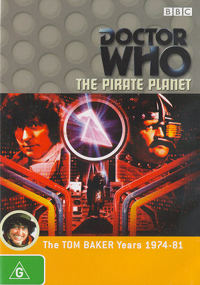Kill The Creature, Or Doom The Earth?: Doctor Who’s History With Moral Conundra
In this week's episode, the Doctor and his companion have to make a tough decision. They should be used to this by now.

This is a recap of the most recent episode of Doctor Who: ‘Kill The Moon’. Spoilers ahead.
–
How exactly does a moral conundrum work?
When characters are faced with an impossible choice, it’s usually because both options will lead to a catastrophic consequence. They cannot stop bad things happening, so they must decide which bad thing will have to happen.
In pop culture, such choices usually have a get-out-of-jail-free card that undercuts the whole point of the moral conundrum. Let’s look at the Batman films. In 1995’s Batman Forever, the Riddler and Two-Face give Batman the choice of saving either Robin or Nicole Kidman Character, and Batman chooses to save both. In a largely terrible film, this is the worst part: neither the character or the writer can understand what “choosing” means. Christopher Nolan changed that. In 2008’s The Dark Knight, Batman can only save Harvey Dent or Not Katie Holmes, and he makes the decision, discovers he was tricked by the Joker into making the opposite, and both bad consequences result. That’s pretty damn dark.
Doctor Who has an interesting history with moral conundra. The most famous one is in the 1975 classic Genesis of the Daleks: the Doctor holds two wires in his hands. If he connects them, it sets off an explosive that will destroy the Daleks before they’ve even been created. “Have I the right?” he asks, wondering if he can possibly kill innocent organisms because they’ll one day lead to something bad. Sarah Jane can’t believe he’s even questioning it.
It’s the Doctor Who version of the classic hypothetical: could you bring yourself to kill a baby if you were told that baby would one day become Adolf Hitler?

If the Daleks represent Nazis, then these wires represent wires that might kill all the Nazis. Look, it’s not a flawless analogy.
Speaking of killing Hitler: 2011’s Let’s Kill Hitler. The brilliance of this episode was that the title was both metaphorical and literal. Yes, they went back and met Hitler and debated killing him, but that’s not what the episode was about. River Song was trained to kill the Doctor, because his very existence would one day lead to the most catastrophic of wars. To her, the Doctor is Hitler, and we’re suddenly on the other side of this. For an episode that plays like a romantic-comedy-adventure, it was actually one of the better examples of a difficult choice in the show’s history.
Basically, the Doctor cannot be faced with the decision of killing either Innocent Being A or Innocent Being B and then have to actually go through with it. That’s an horrific idea for a kids’ show, and you certainly don’t want him killing people every week. But you also don’t want to disregard the idea that there are difficult decisions in life, and that not everything can work out for the best. Because if it is a kids’ show – and last week we established that it was – then that’s an important lesson to learn.
Two other stories came to mind when watching Kill The Moon. The first was 2010’s The Beast Below, in which the Doctor can either save the inhabitants of the Starship UK, or save the life of the Star Whale transporting them — but he can’t save both. “And then I find a new name, ’ cause I won’t be the Doctor anymore.” As we later discover in both The Night of the Doctor and The Day of the Doctor, it’s a decision he’s made before: too difficult a choice, and he ceases to be the Doctor. So does that mean the Doctor is someone who can’t make difficult decisions, or someone who always finds a way around them?
The other story that I thought of while watching this week’s episode was the 2007 Christmas Special, The Runaway Bride, in which it’s revealed that the Earth has been incubating giant spiders since the dawn of time. The Doctor then drowns them all with the Thames, moral conundrum sorted! But this decision is used to show that the Doctor can sometimes go too far if there’s no one to pull him back — so his choice is not dismissed as easy, or even right. The danger isn’t that the Doctor won’t make a decision; it’s that he will.
This week we learned that the Moon is also full of giant spiders. Doctor Who is full of many important lessons, but I’ve decided the most important one is that deep down, aren’t we all full of spiders? Not a metaphor.
The moral conundrum in this episode is a good one. The moon is – and always has been – a big egg: an incredibly neat idea that must have been irresistible to writer Peter Harness. But the beast inside is about to hatch, and if it does, that’s the Earth gone.
So do we kill the creature, or doom the Earth?
Clara broadcasting the issue to the entire Earth and getting humanity to vote on whether to kill the creature or not is something that could only be done in the age of reality television, which I think will be the biggest takeaway from this episode in decades to come.
Allowing the creature to live, and discovering that this act is a win-win situation, is not actually a cop-out in the moral conundrum area. Although I wish Clara would have to spend a moment dealing with the fact that she’d just doomed the Earth to death in order to save a giant bug, the Live and Let Live message is a strong one, and the laying-of-a-new-moon-egg is a great resolution to this. But: did it have to happen off-screen? I’m sure it would have been expensive to animate, but given this is one of the most important moments in the entire program, actually seeing it rather than having someone go, “Oh look, it’s laid an egg!” and then cutting to a fully-formed moon does feel a tad silly.
While the guest characters of Kill The Moon could have used more back story, this episode has the two most important things that Doctor Who can have: a good central idea, and a lot of giant spiders.
–
Questions To Ponder:
- Can we get a count on how many “last of its kind” beings the Doctor comes across? It almost seems like he says it if it happens to be the only one he can see. “Ah, a common house cat. The last of its kind. Alone in a cruel univ— no wait, there’s another one over there. Never mind.”
- Where did the Doctor go when he disappeared? I have a theory: when Clara asks how Danny got so wise, he says that he had a bad day. My money’s on the Doctor’s little disappearance resulting in a trip with Danny, which we may see later in the season. I’ll claim five bucks from each of you if I’m right.
- The idea of a fixed point in time – something the Doctor cannot change without disrupting everything – was cleverly introduced in 2008’s The Fires of Pompeii, and explains why the Doctor can’t stop some of the worst moments in human history. This episode introduces the idea of “grey areas”, moments where something big is to happen, but he can’t tell one way or the other. Nice storytelling conceit that gets us out of a lot of tricky moments.
- Does the Doctor keep a bunch of TARDIS-controlling DVDs on hand? Clever use of the concept introduced in 2007’s Blink.
- The gravity yo-yo is back! The Fourth Doctor used a yo-yo to check out the gravity of the Nerva Beacon in 1975’s The Ark In Space.
- The Doctor doesn’t know if he still has a regeneration limit? So he could have more than twelve lives left? Expect this to impact the 26th Doctor in the 100th anniversary celebration in 2063. I’m only half joking.
- Did the Doctor say that Courtney becomes President of the United States? Why is the fact that she has an English accent the only thing that bothers me about this revelation? (Also, she marries a bloke called “Blinovitch”, which will delight the nerdier fans. Which, if you’re still reading, is all of you.)
- So how do the events of this episode affect the Moon in other Doctor Who stories? We won’t cover every single one, but it does actually fit very nicely in with key moon-set stories such as 1967’s The Moonbase (set in 2070) and 1969’s The Seeds of Doom (set in “the late 21st century”). It doesn’t actually appear to contradict the origin story given in 1997’s novel Eternity Weeps, which says that the moon was originally orbiting the Cthalctose home world. I know this was keeping most of you up at night. Also: given Kill the Moon is set in 2049, and 2009’s The Waters of Mars establishes that there was a German moon mission taking place in 2050, we can assume that the purpose of the mission was to check out this new moon. Isn’t continuity fun? I SAID ISN’T CONTINUITY FUN?
–
Throwback Thalday
 Did this episode leave you jonesing for more stories about planets turning out to be something they’re not? Then 1978’s The Pirate Planet is for you.
Did this episode leave you jonesing for more stories about planets turning out to be something they’re not? Then 1978’s The Pirate Planet is for you.
Written by Douglas Adams, this is a tremendously funny story that has a great concept which I won’t spoil for you. Yes, spoiling things that came out in 1978 is a thing. Now go buy the DVD, there’s a good reader.
–
Lee Zachariah is a writer and journalist. He co-hosted the ABC2 film comedy series The Bazura Project, and is a co-presenter of film podcast Hell Is For Hyphenates. He tweets at @leezachariah



